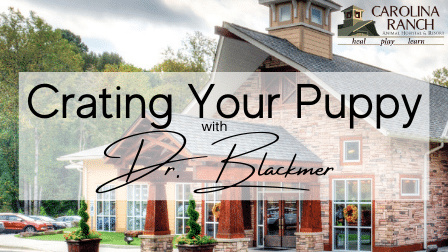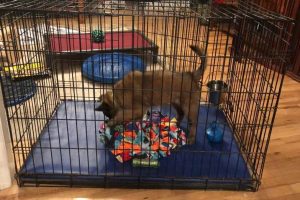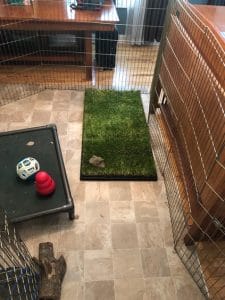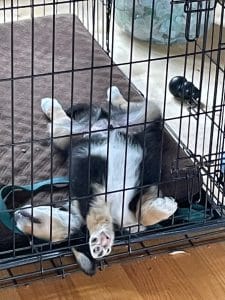A Gated Community — Crating Your Puppy

CRATES and EX PENS and PUPPY CONFINEMENT
Let’s face it; we’re all beyond busy. So, as we go about our many tasks during the day, our puppy needs to be safe. That means keeping her away from electrical cords, the other dogs, the garbage, and the cat. If we could watch the puppy every minute, maybe we wouldn’t need a way to confine her. But think about this – at some point our puppy will have to be alone and when she becomes an adult dog, she’ll need to be alone from time to time as well. Getting your adult dog to be comfortable with being home alone starts when she’s a puppy. So get at least one crate. Trust me.
NIGHT TIME ARRANGEMENTS
Your puppy’s sleeping crate can be either wire or plastic. I personally prefer the plastic crate for nighttime because there’s less visual stimulation. With one of my dogs, I also used a crate cover for her early months. The crate cover helped prevent sleep deprivation for the human Mama. Any movement in the bedroom was especially stimulating for that puppy (as in she woke up ready to play). My current puppy is fine with no crate cover, bless him.
So imagine your puppy’s first night with you – she’s left her litter where she was used to sleeping every night in a pile with her brothers and sisters. They kept each other warm and provided companionship. Mom was nearby, so everyone felt safe. Tonight, your puppy’s first night at home, is going to be a huge transition. So let’s make it easier for her.
For the first few nights I’d strongly urge you to have her sleeping crate where she can smell you, see you and feel your fingers near her. Put her crate on your nightstand. You can do this – it’s only for a few nights. Make sure she has some water, a toy, and a soft blanket. Only put her in her nighttime crate when you’re ready to go to bed yourself. Don’t make a big deal out of it, just say good night, place her in the crate and close the door. Get into bed yourself and if she’s not settled down immediately, you can put your fingers in the crate, but don’t talk to her. Just be there. She’s very likely to fall quietly asleep.
If she gets restless and cries during the night, take her out to potty. Again, don’t make a big deal out of it. Get out of bed, put on your slippers and bathrobe, open her crate and pick up your puppy. Carry her outside. Put her down and let her do her business. When she’s done, pick her up and carry her back to her crate, all without much ceremony. Honestly, you’ll be half asleep yourself, so this shouldn’t be hard. Put her back in her crate. Get back in bed. Don’t talk to her. Don’t give her treats (not even for pottying outside). You want this midnight trip outside to be completely and 100% boring. If she fusses in her crate, put your fingers through the crate door and just be there, like Mom or her littermates would.
Not long ago, my husband and I brought home a puppy (and I daily alternated between being elated and saying, “What was I thinking?”). I kept in close touch with the other 5 puppy parents of our litter. Nearly all of us created this nighttime setup. Those of us who did had puppies easily sleeping through the first night without complaint. The one who didn’t had a puppy screaming off and on for much of the night. The second night he did what the other puppy people were doing and, voilà, peaceful night. It was like magic!
NIGHTTIME CRATING, NEXT STEPS
Once your puppy is comfortable in her new home and sleeping quietly at night without any fussing, you can go to step two. This will probably take 3 or 4 nights. Now you can have your nightstand back because we’re going to move the crate to the floor. Put it right next to the nightstand. If the first night with the crate on the floor is no big deal, great, the next night, move it to the foot of the bed. You get the idea, incrementally, as your puppy is successful, you’ll move it to where you want it to be located for the next few months to a year or more (depending on the percentage of devil gene in your puppy).
I strongly urge you to consider keeping the sleeping crate in the bedroom. After all, pups are pack-oriented and this is what will feel natural to them. But if you’re absolutely set on having that crate out of the bedroom, just follow the above plan to slowly and incrementally move it to its final location.
DAY TIME ARRANGEMENTS
Crate and Ex-Pen
Your puppy needs a safe place whether you’re heading to work or you’re home and need a little me time. Let’s face it, even though the puppy is incredibly cute, we all want occasional freedom from the need to constantly focus on puppy’s next potty break, what she’s dragging around now, and whether she’s chewing on a toy or the couch. Let’s set up her very own special place.
The general idea is you’re going to set up a crate with an exercise pen (ex-pen) attached to it. She’ll have her sleeping spot and her romping area right next to each other. You’ll put vinyl flooring underneath the whole shebang to protect your flooring or carpet.
Pick a place for the day-time crate that’s near enough to the general activity of the household that your puppy can be in there and still feel a part of the family. Purchase a crate with two doors (the metal variety often comes with two doors and is easiest to attach to an ex-pen).
Next pick out an exercise pen that’s large enough for your puppy to move around in but small enough to fit in the space you’ve chosen. The size of both the crate and the ex-pen should be based on your teenaged puppy rather than the cute 8-week-old ball of fluff you’re bringing home. The height of the ex pen can be three feet for little dogs but consider 4 or even 5 feet in height for large breeds especially those that are, um, mischievous by nature. We don’t want your puppy to even try to jump or climb out of the ex-pen.
For my puppy who will be 60 lbs as an adult, I use one that’s 5 ft. high. Really. That height does two things – it makes it very unlikely that my puppy will ever be able to jump out of it. It also prevents me from reaching over the top of it. If you don’t reach over the top of it to pick up your puppy, she’s less likely to try to climb over it to get to you.
What about the carpet or the brand new oak hardwood floor underneath the crate and ex-pen? Puppies have accidents and they LOVE to tear at things, so we need to keep the beautiful carpet safe. It’s time for a trip to Lowe’s or Home Depot to pick up a piece of vinyl flooring. They sell small sections of it – 6 ft. x 9 ft. should do nicely for most families and you can cut it to size from there if that’s too big for your Papillon puppy’s daytime area. Since the vinyl flooring can be trimmed to size, if you’re not sure, get a little extra (like I wish I’d done the last time I had this set up in my dining room/kitchen area).
Place the vinyl flooring down then open up your ex-pen on top of it. Set up your crate at one end so that one door opens into the ex-pen and the other door opens up to the household. Attach the crate to the ex-pen with zip ties or small clips. You’ll want to use clips on one side because you need a way in and out of the play area. As I said earlier, you should avoid stepping over the ex-pen when the puppy’s there. She’ll learn really quickly how to climb out if she sees you do it. I know, I know, puppies supposedly don’t learn by watching… Murphy’s law has shown that if it’s going to happen, it’ll happen with some behavior you really don’t want her to learn!

Furnishings
Place a soft bed (for nonchewers) or a thick, fitted pad (for chewers) into the crate. If you’re not sure which you’ll have, bet on a chewer. I love Primo Pads (www.primopads.com) – they make many sizes to fit standard crates and they also will create a custom pad for you for a reasonable price.
Hang a water bucket inside the crate. I prefer water buckets to bowls as they’re less tippable. Though a dedicated mayhem artist can still make spills happen (eh hem, Seeker…). As I’ve said elsewhere, I’m not a big fan of feeding puppies using standard food bowls; we’ve got other uses for all of the food she’ll get. So shelve the pretty food bowl that matches the water bowl, just for a while.
When you have food left over from training and you’d like to offer it in the crate or ex-pen, consider food puzzles or slow feeders. We have a whole blog on that topic coming soon.
Leave toys for your puppy to play with but always test drive them first – you want to make really sure your pup isn’t going to disembowel the adorable $25 stuffed dragon and eat the stuffing, treating you to a big vet bill in her first month home. You can use chew toys but ensure that they’re safe to ingest. I’m a fan of large carrots, frozen dog treats in an empty toilet paper roll with the ends pinched off, or stuffed Kongs. Again, test drive everything first while you’re monitoring to make sure your puppy isn’t swallowing pieces of any of his nonedible toys.
Consider a cot for your pup to lie on (pounce on, crawl under, move around) in the play area. Some of the cots available have the cloth portion completely contained within the plastic edging so that the puppy can’t chew on the cloth. The plastic edging is still fair game (sigh… Seeker).
I also add in cardboard boxes for entertainment’s sake.
Indoor Bathroom
For those of us with full time jobs, accidents are probably going to happen in the ex-pen. With my most recent puppy I learned about Fresh Patch – where has this been for the last 6 puppies?? Fresh Patch is sod (yup, grass and dirt) that arrives in its own waxed cardboard box. You place it right in the ex-pen – a little Mother Nature right there for your puppy to use. I know, I know. This sounds super fancy and it’s a little pricey. But you absolutely can’t beat it for house training when you have to leave your puppy at home long enough that a crate alone is insufficient, and the ex-pen allows enough room for easy accidents.

PACK MANAGEMENT
While we’re on the subject of managing our little heathen, I mean puppy, what about when she’s out in the house with us? We need to go about our daily life but also provide plenty of learning opportunities so that puppy grows up to be the teenager we can live with. If you have multiple dogs, you also want to be able to work with your puppy without having the adults horning in on the cookies and playtime going on. That’s where baby gates come in.
In this video you’ll see baby Péle learning tricks in various places around the house. I use baby gates and ex-pens to manage the space, adults on one side, me and the puppy on the other.
Péle Puppy Training with Barriers
The kitchen is where I spend most of my early morning, before-I-go-to-work time. I want my puppy with me where I can entertain her, teach her, and, let’s be honest, keep an eye on her! I set up baby gates so that the adult dogs are excluded and I can focus on the puppy.
As I go about my chores, I offer her toys to play with (anything novel will do - an empty plastic bottle with some kibble in it, a strawberry, an ice cube). I periodically stop what I’m doing to call her name and reward her for coming then toss a kibble and tell her “Get it!”. If she picks up something she’s not supposed to have, it’s the perfect opportunity to practice “Trade” – I give an amazing treat and my puppy drops the dish towel, dustpan, spoon, or whatever she’s most recently grabbed. We’re training our puppy every minute of every day; let’s teach what we want them to learn instead of managing mayhem.
Seeker Entertainment in the Kitchen

Dr. Rachel Blackmer
DVM, Dip ABVP (Canine, Feline), CCRT
Puppies typically stay in their crates at night because it teaches them to sleep all night long. In the early stages of training, place the crate directly next to your bed so that your puppy does not feel lonely or scared and can easily wake you up for a toilet break.
Leaving pee pads in your puppy's crate is not a good strategy. In addition to being a chewing concern, it will begin to educate your puppy that it is OK to urinate in their kennel. For your puppy's long-term confinement quarters, pee pads can be utilized.
Fresh water is essential for your developing pup, but it's never a good idea to leave it in the crate since it might make housebreaking difficult. Dogs naturally dislike going to the bathroom in their den, so crate training is a useful aid in the process. However, if you give your puppy access to water, she will drink whenever she feels thirsty and won't be able to contain her little bladder. Repeated accidents may severely hinder the process of housebreaking your puppy, in addition to causing you and them stress and anguish. While it's not a good idea to keep water in the crate, you should never restrict your puppy's access to water when housebreaking them. Provide easy access to water, and before crate training, make sure she has had a chance to eliminate adequately.





